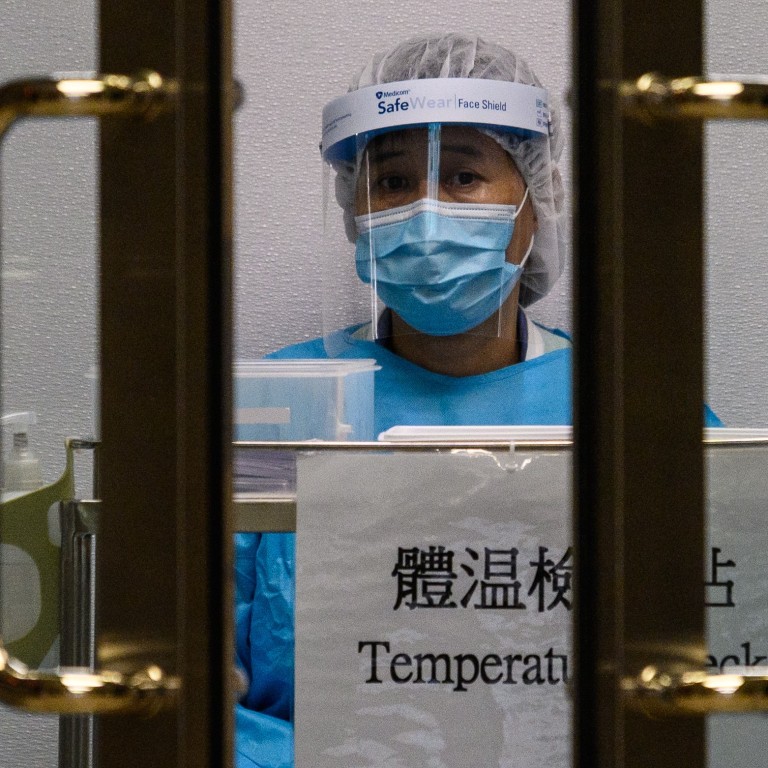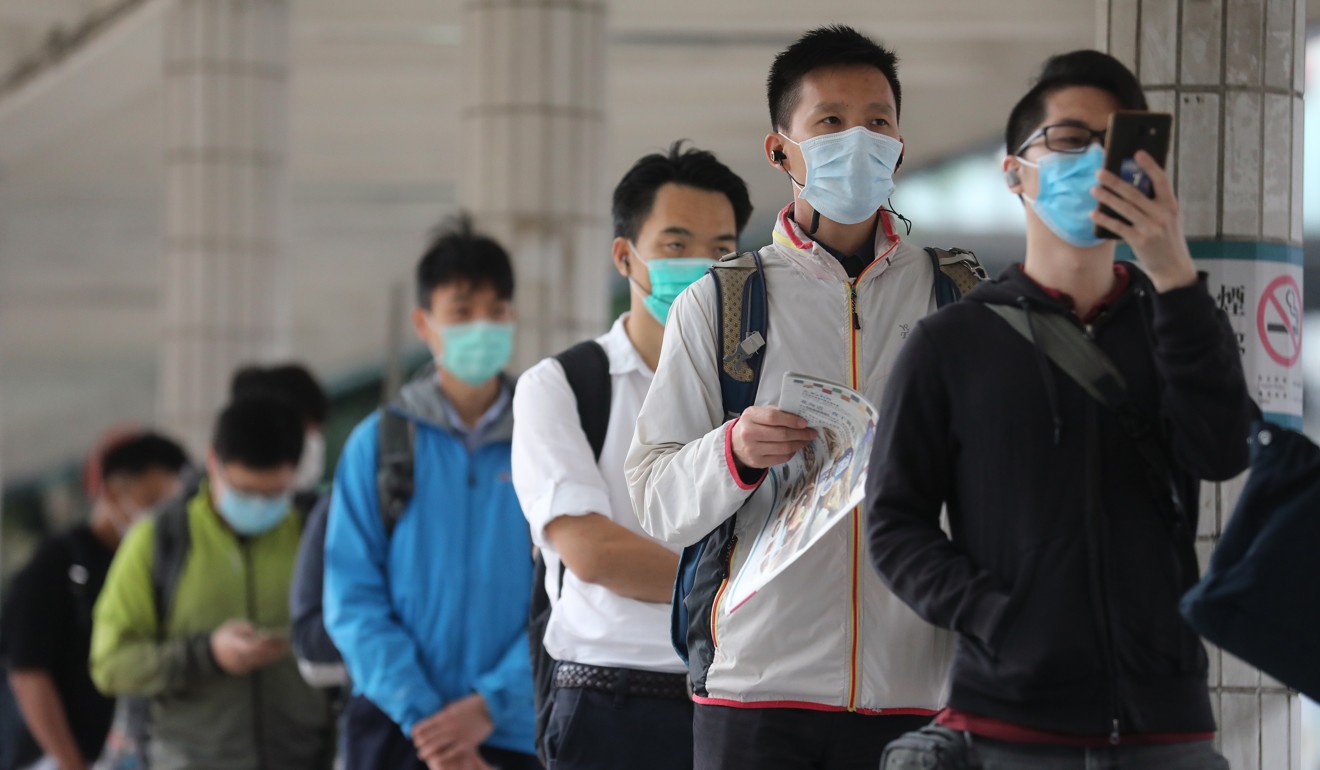
Coronavirus: Hong Kong may turn sports and expo centres into temporary hospitals, sources say
- Coliseum in Hung Hom is one option being considered as public hospitals begin to run out of isolation space
- Contingency plan comes as city reports 41 new infections, most of them from overseas
Sources said Chief Executive Carrie Lam Cheng Yuet-ngor’s advisers in the Executive Council would discuss options on Tuesday, including the use of the Hong Kong Coliseum in Hung Hom, if public hospitals became overwhelmed by the daily surge of imported and community-spread infections.
Another 41 infections confirmed on Monday took the city’s total to 682, most of them coming from overseas, as experts warned the situation was “severe”, even “a little out of control”, and suggested isolating patients showing mild to no symptoms in government facilities or even at home instead of using up precious hospital space.
“The government has to plan ahead. For patients who have no infection symptoms and would not require oxygen support, we could place them together in areas such as sports centres if the situation worsens,” a source said.
“The Hong Kong Coliseum would be an option given the large space it has. Other sports and exhibition facilities in the city could be a choice as well.”
The areas will not have negative-pressure wards that restrict airflow but ventilation would be sufficient and patients separated.
The government would meet its expert team advising on containment strategy this week to discuss how to manage the rising caseload and shortage of hospital space, the source said.
A member of Lam’s panel of medical experts, Professor David Hui Shu-Cheong, said Britain, Italy and Spain had taken over sports and exhibition centres to deal with the overflow from the health care system.
Coronavirus may cause food shortages
“We are talking about an extreme case, such as a sudden surge of 2,000 cases in the city,” Hui told the Post. “We may use part of the Hong Kong Convention and Exhibition Centre in Wan Chai, or the AsiaWorld-Expo, just like how England is turning the exhibition area, the ExCeL London, into a temporary hospital.”
Once the facilities were converted, recovered patients or those showing no symptoms could be transferred. “Overseas examples show if there is enough ventilation within the area, they can help to deal with infectious diseases,” he said.
The Food and Environmental Hygiene Department has inspected 3,200 catering locations and issued 280 reminders to comply with the new rules such as checking patrons’ body temperature and ensuring tables are spaced at least 1.5 metres apart. The authorities had also checked dozens of premises in the nightlife area but no violations were noticed.
Exco member Ronny Tong Ka-wah said all eateries could be shut if the number of cases continued to rise rapidly.
The latest patients were aged between 11 and 65, with 34 having a history of recent travel – 17 of them students returning from overseas, said Dr Chuang Shuk-kwan, head of the communicable disease branch of the Centre for Health Protection.
But what was more “worrying”, Chuang said, was that four of the newly infected involved local transmission of unknown origin, including a frontline police officer who went on a picnic with friends in the West Kowloon Cultural District on March 27.
Another new case involved a nursing student from Open University who visited the All Night Long bar in Tsim Sha Tsui, which has been linked to a cluster of infections.

Dr Lau Ka-hin, the Hospital Authority’s chief manager of quality and standards, said the city was running out of isolation beds. Some 40 infected people were still waiting to be admitted as of Monday night.
“The Hospital Authority has been in discussion with the government, such as the Department of Health, throughout on alternative options if there are more patients but we can no longer take them in,” Lau said.
While stopping short of providing specific details, Lau did not rule out using beds in private hospitals as all options were being considered.
But he said sending recovering patients home early for self-isolation, as other experts have suggested, including the authority’s own chief executive Dr Ko Pat-sing, could be problematic.
Hong Kong jails men who flouted Covid-19 quarantine rules
“For places outside the hospitals, it’s not something up to the Hospital Authority alone to decide,” Lau said. The government and private owners would need to be consulted.
Lau revealed that isolation wards at some hospitals had already reached capacity. Some 489 patients were being treated treatment in 14 public hospitals, five of whom were in critical condition, while six more had been discharged, taking the total to 124, the authority said. Hong Kong has recorded four deaths from the virus.
But hospital capacity remained tight as 65 per cent of the city’s 1,012 isolation beds remained occupied, while 77 per cent of its 534 isolation wards were in use. There were 820 beds for adults, 126 for children, with the rest located in intensive care units.

The authority earlier announced 400 “second-tier” beds – ordinary ones converted by adding negative-pressure facilities – would be available by the end of the week.
Lau said an infectious disease committee met on Monday morning to determine which patients could be transferred. They must be free of fever for more than 48 hours, without respiratory symptoms or diarrhoea for 10 days and not require oxygen support. The patients must also have shown improvement in their blood tests.
Lau also pledged to allocate beds for confirmed cases as soon as possible after it was revealed that a person living in a subdivided flat who tested positive two days ago was not picked up by an ambulance until Monday afternoon.
Professor Yuen Kwok-yung, an infectious diseases expert at the University of Hong Kong (HKU), warned that the number of cases could continue to surge because of the tens of thousands of residents returning home from around the world.
“Hong Kong is now facing a severe situation,” he told a radio programme. “Some citizens have let their guards down on maintaining personal hygiene as the pandemic has entered the third month – the situation is becoming a little out of control.”
Strategy shift may mean placing less-severe virus cases in community: experts
Yuen suggested patients with mild or no symptoms be sent to quarantine facilities rather than hospitals to ease the burden on the health care system.
“For those infected young people who have only mild symptoms, such as having only a sore throat or runny nose without any fever, they could be placed in quarantine facilities like Chung Yeung Estate [in Fo Tan],” he said. “They won’t need treatment by medical workers. They can even return home for further self-quarantine after their viral loads are lowered.”
He said patients who did not display symptoms and with a low viral load should be a low transmission risk.
But Dr Ho Pak-leung, a leading microbiologist from HKU, cautioned that patients with mild symptoms transferred out of hospital should not return home until testing negative for the virus.
“Patients who still have their stool, sputum or other samples test positive should not be allowed to return home … as they could still infect others [living there],” Ho said.
The medical school at Chinese University began on Sunday offering free stool tests for young children arriving at Hong Kong International Airport as an alternative to deep-throat saliva tests, which the government now uses but has a false negative rate of more than 40 per cent if the samples were not collected properly.
The Legislative Council became the latest in a long list of key institutions to be affected by the outbreak, announcing its weekly meeting on Wednesday was cancelled.



